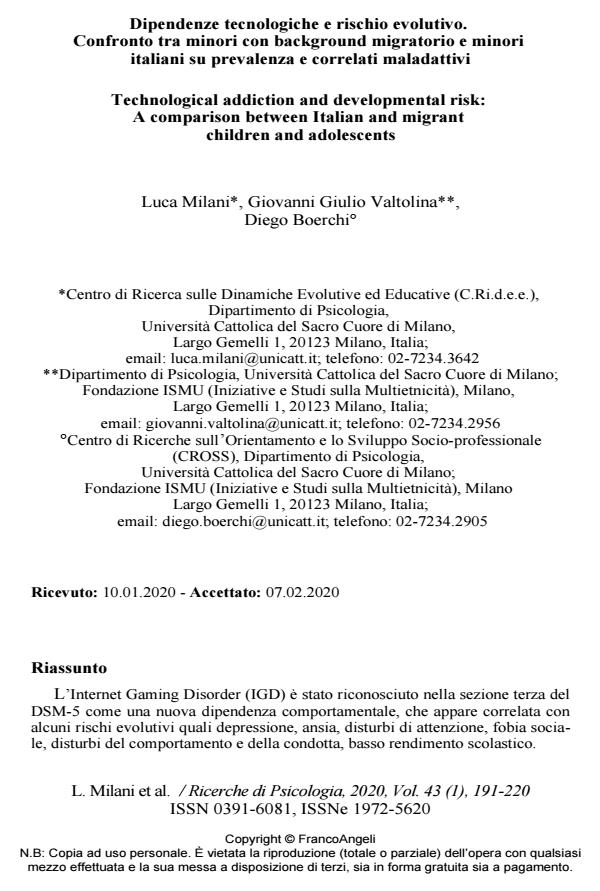Technological addiction and developmental risk: A comparison between Italian and migrant children and adolescents
Journal title RICERCHE DI PSICOLOGIA
Author/s Luca Milani, Giovanni Giulio Valtolina, Diego Boerchi
Publishing Year 2020 Issue 2020/1
Language Italian Pages 30 P. 191-220 File size 286 KB
DOI 10.3280/RIP2020-001009
DOI is like a bar code for intellectual property: to have more infomation
click here
Below, you can see the article first page
If you want to buy this article in PDF format, you can do it, following the instructions to buy download credits

FrancoAngeli is member of Publishers International Linking Association, Inc (PILA), a not-for-profit association which run the CrossRef service enabling links to and from online scholarly content.
Abstract The Internet Gaming Disorder (IGD) has been included in the third section of the DSM-5 as a new behavioral addiction, related to some developmental risks such as depression, anxiety, attention disorders, social phobia, behavioural disorders, low academic performance. Similar to the IGD, the Internet Addiction (AI) has also been studied as a behavioral addiction related to an uncontrolled use of the Web for the purpose of mood modulation. The Internet Addiction has in turn been correlated with numerous devlopmental risks, both in terms of internalization and externalization. Given the vulnerability of migrant populations to behavioral addiction such as gambling disorder, it is important to check whether this vulnerability also includes technological dependencies: IGD and IA. The aims of the present study are: 1) to obtain prevalence data of IGD and IA in students with a migration background, 2) to highlight any maladaptive differences related to technological dependencies in minors with a migratory background. 528 students (673.3% females), aged between 9 and 20 years old (M = 15.76; DS = 2.176), and attending secondary schools of first and second grade in 4 Italian cities, participated to a specific survey on the topic. 9.7% of the students declared that they do not have Italian citizenship. The reserch tools were: VGA Questionnaire (VGA) to measure the Internet Gaming Addiction; Internet Addiction Test (IAT), to evaluate Internet addiction; Children’s Coping Strategies Checklist – Revised 1 (CCSC-R1) to measure coping strategies in difficult situations; Interpersonal Relationship Test (TRI) to estimate the quality of social relationships in different domains. 6.1% of students without Italian citizenship meet the diagnostic criteria for IGD, compared to 2.0% of Italian participants, while there is no statistically significant difference regarding internet addiction. 4.5% of males meet the diagnostic criteria for IGD, against 1.2% of females, while the situation is the opposite with regard to internet addiction: 12.2% for females versus 8.8% of males. Regression models show that being an migrant is a likely risk factor for IGD, along with distraction and avoidant coping strategies. On the contrary, migrant status appears no to be a risk factor for Internet addiction. The results of this study seem to indicate a higher prevalence of IGD in the student population with non-Italian citizenship and confirm that the migratory background appears to be a potential risk factor for the development of the disorder.
Keywords: Internet addiction, internet gaming disorder, migration, developmental risk.
- Migrazioni e psicologie. Introduzione al Forum Alessandro Antonietti, Antonella Marchetti, in RICERCHE DI PSICOLOGIA 1/2020 pp.13
DOI: 10.3280/RIP2020-001002 - Factorial structure of the Internet Gaming Disorder questionnaire in the Italian setting: a single-factored ailment or a multifaceted condition? Luca Milani, Douglas A. Gentile, in European Child & Adolescent Psychiatry /2024 pp.2657
DOI: 10.1007/s00787-023-02322-5
Luca Milani, Giovanni Giulio Valtolina, Diego Boerchi, Dipendenze tecnologiche e rischio evolutivo. Confronto tra minori con background migratorio e minori italiani su prevalenza e correlati maladattivi in "RICERCHE DI PSICOLOGIA " 1/2020, pp 191-220, DOI: 10.3280/RIP2020-001009